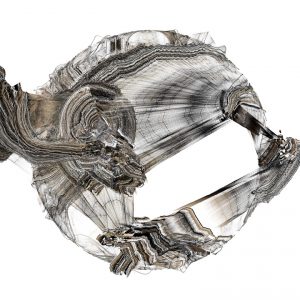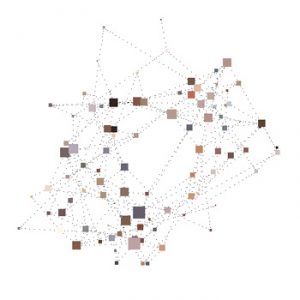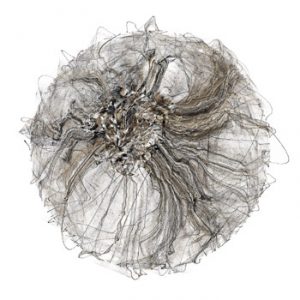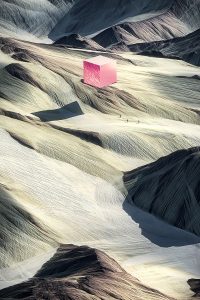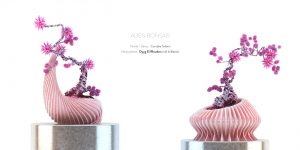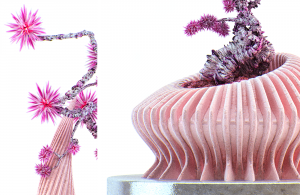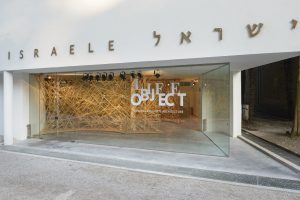sketch
function setup() {
createCanvas(200, 480);
}
function draw() {
var from = color(127, 188, 215);
var to = color(255);
setGradient(0, height, from, to);
var h = hour();
var m = minute();
var s = second();
noStroke();
r = map(h, 0, 24, 190, 0);
g = map(h, 0, 24, 255, 80);
b = map(h, 0, 24, 180, 30);
fill(r, g, b);
rect(0, height-30, width, 30);
var positionY = map(m, 0, 60, 416, 156);
upHouse(positionY);
for (var i = 0; i < s; i++) {
frameRate(1); strokeWeight(.25);
balloonX = random(85, 135);
balloonY = random(65, 120);
line(105, positionY-37, balloonX, positionY-balloonY);
fill(random(249, 255), random(140, 255), random(150, 200));
ellipse(balloonX, positionY-balloonY, 11, 14);
}
}
function setGradient (y, h, from, to) {
for (var i = y; i <= y+h; i++) {
var inter = map(i, y, y+h, 0, 1);
var c = lerpColor(from, to, inter);
stroke(c);
strokeWeight(2);
line(y, i, y+h, i);
}
}
function upHouse (y) {
noStroke();
fill(245, 202, 170);
rect(73, y, 62, 38);
fill(126, 176, 200);
rect(73, y, 62, 10);
fill(51);
quad(74, y-28, 136, y-28, 144, y, 66, y);
fill(88, 67, 50);
rect(102, y-36, 6, 10);
fill(78, 60, 45);
rect(95, y+5, 9, 25);
fill(99, 71, 59);
rect(72, y+27, 18, 11);
for (var i = 0; i < 4; i++) {
fill(255);
stroke(150);
strokeWeight(0.25);
rect(90, y+27+2.75*i, 18.5, 2.75);
}
noStroke();
fill(255);
rect(74, y, 2, 27);
rect(88, y, 2, 27);
rect(76, y+13, 12, 2);
rect(79, y+15, 2, 12);
rect(83, y+15, 2, 12);
fill(187, 202, 94);
rect(108, y, 28, 38);
fill(245, 248, 162);
triangle(104, y+5, 140, y+5, 122, y-38);
rect(84, y-20, 12, 10);
triangle(82, y-18, 98, y-18, 90, y-30);
stroke(141, 202, 233);
strokeWeight(3.5);
line(140, y, 122, y-38);
line(122, y-38, 104, y);
line(98, y-18, 90, y-30);
line(90, y-30, 82, y-18);
fill(240, 208, 100);
stroke(265);
strokeWeight(1);
rect(86, y-20, 6, 7);
rect(116, y-14, 10, 10);
rect(115, y+14, 12, 14);
}
*sketch updated to modified code based on question on Piazza
I was inspired by the movie “UP” to create this abstract clock design. The number of balloons increases every second while moving around to random points to illustrate the balloons floating in the air. The number of balloons goes back to 0 when it hits the next minute. The color of the balloons are also randomized within a range to have variety of shades. Each minute is indicated by the house’s Y position as the house moves up. The ground color slowly changes every hour to indicate the current time. A separate function had to be created to generate the house, which uses variable y that is mapped to minute().
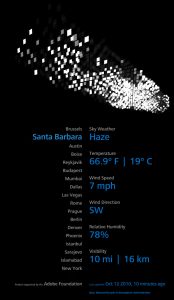

![[OLD FALL 2017] 15-104 • Introduction to Computing for Creative Practice](../../../../wp-content/uploads/2020/08/stop-banner.png)
